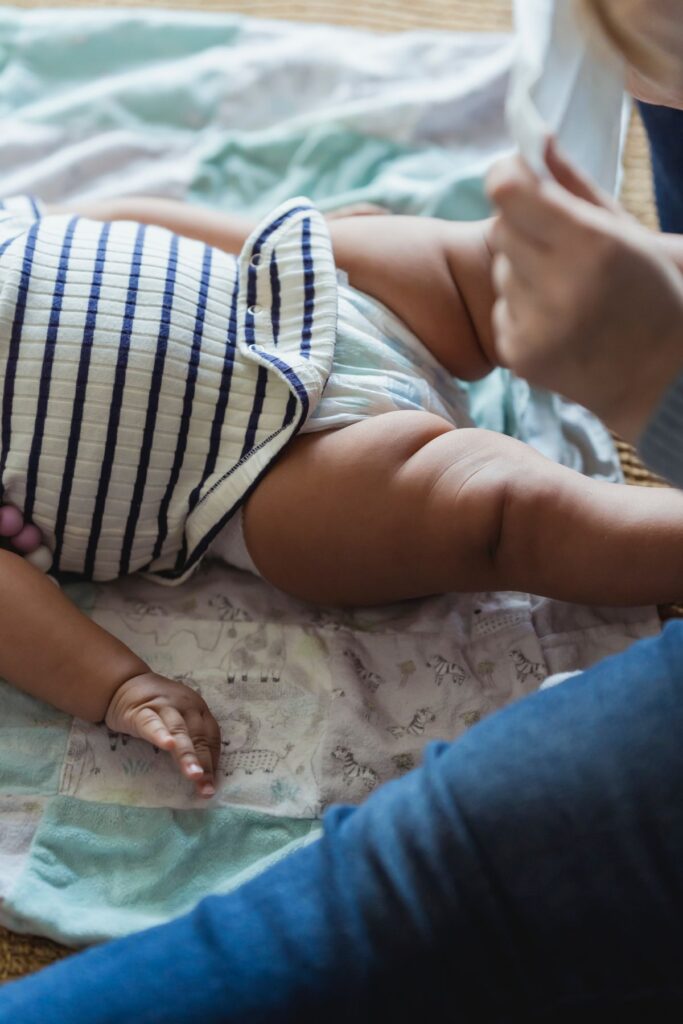Diaper rash is a common problem for babies and can be a pain for both baby and parent. There are many different types of diaper rash, and each one has its symptoms and causes.
This blog post will cover the different types of diaper rash, their common symptoms, and how to treat them.
Table of Contents
Diaper dermatitis
Sometimes, diaper rash is referred to as ‘diaper dermatitis’ or ‘baby skin rashes.’ This can make it seem like quite a scary condition!
Diaper dermatitis usually occurs when there are moisture sources in the baby’s underwear (for example, if they need to go to the bathroom frequently), and their dry skin gets irritated by some of the urine or fecal matter that has penetrated the garment.
This typically happens within the first few days after changing a new set of diapers.
After this period, however, the thick layer of protective mucus at the surface level may begin to thin out or even wash away. This exposes more raw skin, which makes the problem worse.
What should you do?
Try not to touch the affected area with your hands as much as possible. Use a wet paper towel instead. If needed, use a fresh piece of cloth each time, so there’s no lingering chemical residue from the last one.
Dry infant clothes thoroughly using either a low heat setting for ironing or taking them outside to let air circulation work. Avoid using a hairdryer, as this could cause further irritation.
Consult your doctor if the symptoms worsen beyond the tips mentioned above or if the pain becomes too intense.
The rash caused by chafing
Chafing can cause diaper rash, usually around your baby’s ankles or feet, where the foot gets stuck in a wet diaper as it dries.
This can happen when there are folds in the fabric of the panty or wool sock that don’t hold moisture well. Or the infant may get tangled up in the leg straps while putting on the diaper.
Tightly fitted diapers help prevent skin irritation by keeping the child’s legs free to breathe.
However, if the parent has to put off using those products for health reasons, then buying slightly less tight pants or cotton socks is another way to avoid ankle rashing.
Another important factor in preventing chaffing is ensuring your baby is warm enough. Babies should never be left without clothes at temperatures colder than 60°F (15°C).
The rash caused by moisture
The next most common type of diaper rash is called wet-skin syndrome. This happens when your baby licks their skin or comes into contact with sweat, urine, or both for too long.
As mentioned before, dry diapers are the best way to prevent this kind of rashes.
If your child has wet-skin syndrome, try using oil-based lotion instead of cream to treat it. At the same time, many people use cocoa butter as the main ingredient in their lotions, oils such as olive, coconut, or avocado work just as well.
Olive oil is an easy-to-find oil at almost every grocery store, so if you are looking for tips for helping your children’s feet feel better, look up recipes made with olive oil.
Diaper dermatitis caused by a yeast infection
Yeast is a microorganism that exists in many different types of flora or bacteria within our bodies. When there are enough nutrients available, it can grow rapidly.
Yeast loves an overabundance of sugar, so when your baby is eating lots of food and you’re offering them milk, they provide the perfect environment for yeast to grow and begin causing problems.
A bacterial infection causes diaper dermatitis
The most common type of diaper rash is due to an imbalance of bacteria in the skin. Bacteria that thrive in warm, moist environments cause this uncomfortable condition.
Diaper rashes can be acute or chronic, depending on how long they persist. Acute diaper rashes will go away within a few days, but if they don’t, it’s important to identify the source of the problem so you can treat it.
Chronic diaper rashes may occur because your child has dry skin or too much hair in the diapers prevents adequate moisture from being absorbed.
If your baby also suffers from eczema, it is more likely to worsen as time passes since excess oil acts as a protective layer for his skin.
Diaper dermatitis is caused by too much moisture

When your baby is in diapers, check their diaper every few hours for any signs of wetness or sopping. If you notice one of these, try an alternative brand or type of diaper before calling it a washout!
Diapers can cause skin irritation due to all the extra water they retain. This can lead to red, dry, flaky rashes across the thighs, buttocks, and stomach area.
This will also go unnoticed because most parents tend to focus more on how wet the infant is than looking for changes in skin texture.
However, if you see a difference in your child’s skin color, it is important to ensure they are properly dried off!
Another myth about diapering says that powdering little ones help prevent diaper rash. While this may be true when changing a newborn, older babies and toddlers need special care.
The trick is finding a balance between enough moisture and enough powder to protect the skin while still being cost-effective and easy to manage.
Diaper dermatitis is caused by insufficiently dried skin
Sometimes, diaper rash is due to something more serious than just a fun bacteria or fungus infection. In these cases, your body does not like dry skin very well!
Diaper rashes can be caused by either inflammation of pre-existing wounds or new injuries from rubbing against wet diapers or bedding as they dry. Unfortunately, most washable soakers do not leave enough time for the skin to air out completely, which may contribute to this kind of diaper rash.
Diaper dermatitis is caused by a baby using the diaper too much
When your child has run out of diapers or chooses to go through an extended period without changing their clothes, they may develop a rash due to their skin being exposed to poop for longer than it should.
This is called fecal-contact dermatitis and can be uncomfortable and annoying for parents and children.
If your child develops a red patch that feels hot when pressed, they probably have diaper dermatitis. There are several things you can do to treat this rash effectively.
Final Words
If your baby has a diaper rash, it’s important to identify the type of rash so that you can provide the best possible treatment for your little one.
If you’re unsure about what type of rash your baby has or if the rash doesn’t seem to be improving with home treatment, be sure to contact your healthcare provider for further guidance.














